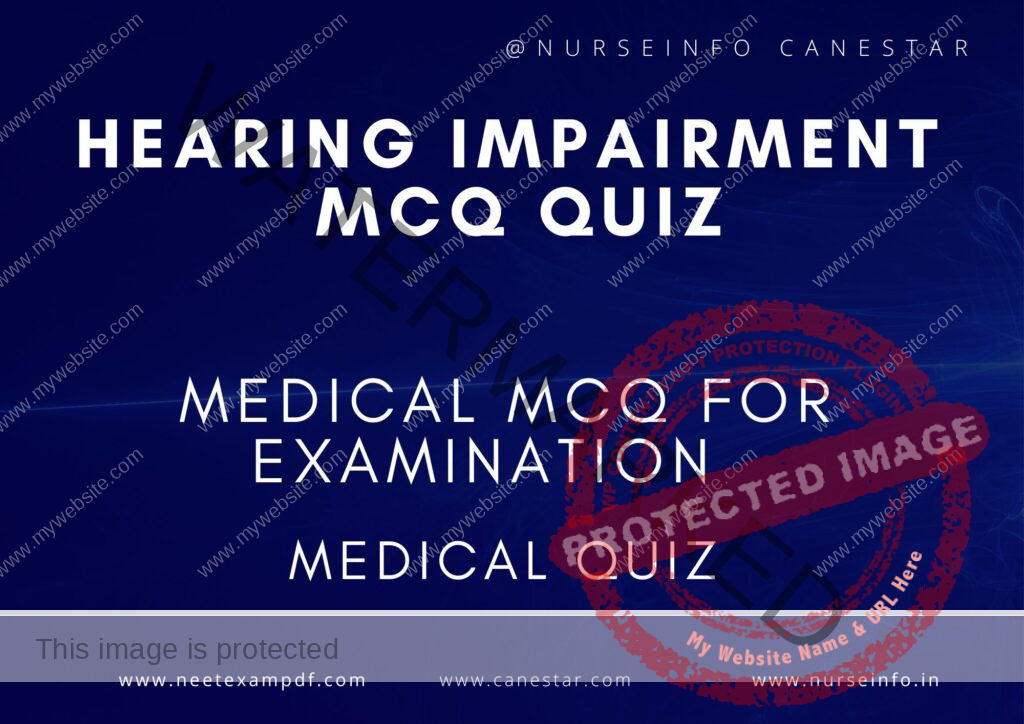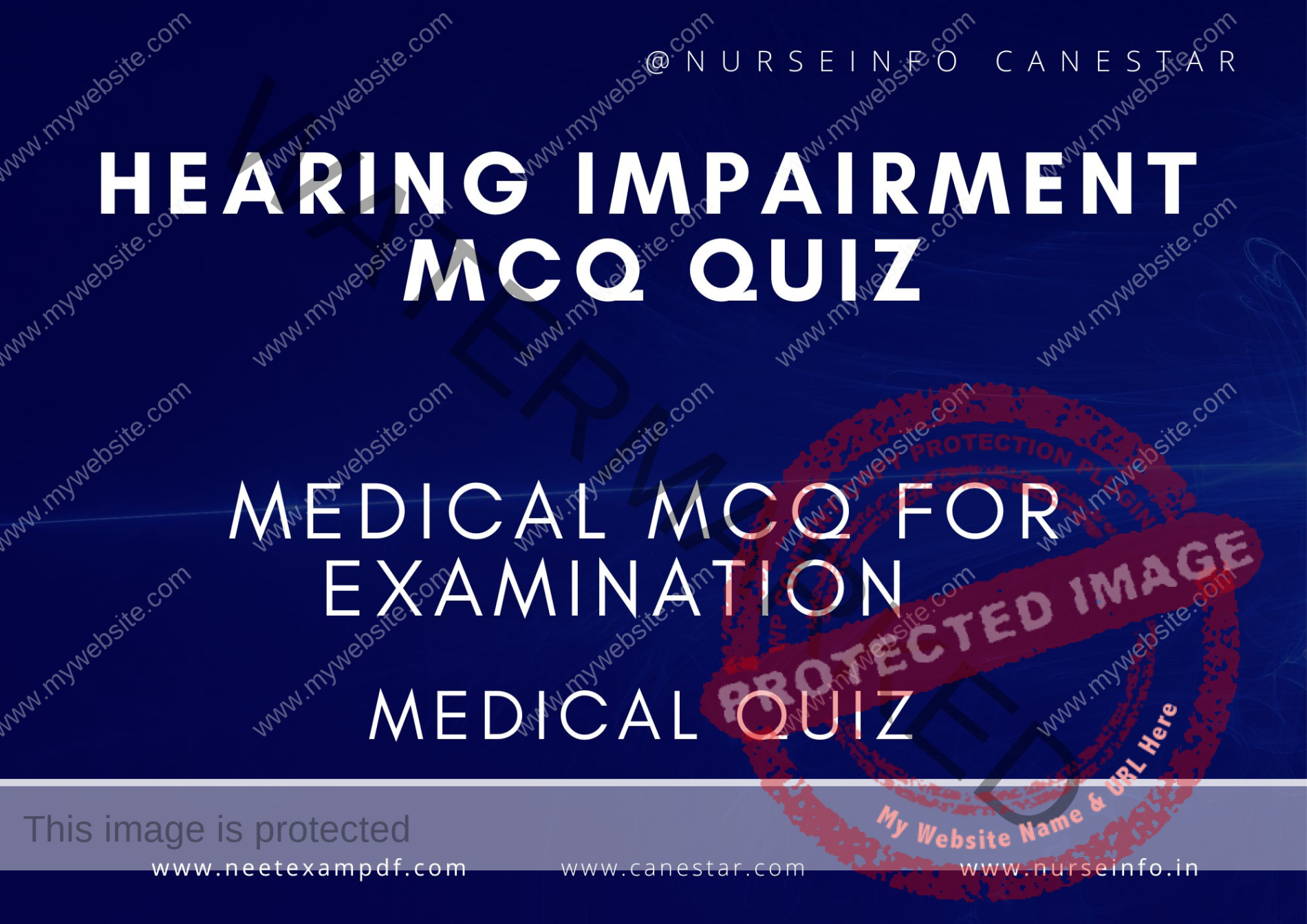MULTIPLE CHOICE QUESTIONS ON HEARING IMPAIRMENT PRACTICE QUIZ – MCQS WITH RATIONALE ANSWER – HEARING IMPAIRMENT MCQ QUESTIONS WITH RATIONALE
MCQ FOR HEARING IMPAIRMENT QUIZ
These mcqs are prepared exclusively for medical professionals for exam preparation. MCQ is helpful to remember the concept on hearing impairment mcq quiz. This multiple choice questions are helpful for preparation for DHA, PROMETRIC, MOH, HAAD, NCLEX, Medical, NEET and Nursing EXAMINATION
HEARING IMPAIRMENT MCQ QUIZ
1. Which of the following is a common cause of conductive hearing loss?
A. Noise exposure
B. Earwax buildup
C. Presbycusis
D. Meniere’s disease
Answer: B. Earwax buildup
Rationale: Conductive hearing loss occurs when sound is blocked in the outer or middle ear. Earwax buildup is a common cause of this type of hearing loss.
2. Sensorineural hearing loss is primarily due to damage to:
A. The auditory nerve
B. The outer ear
C. The middle ear
D. Earwax
Answer: A. The auditory nerve
Rationale: Sensorineural hearing loss occurs when there is damage to the inner ear or the auditory nerve pathways.
3. Which test is used to differentiate between conductive and sensorineural hearing loss?
A. Rinne test
B. Weber test
C. Audiogram
D. Tympanometry
Answer: B. Weber test
Rationale: The Weber test helps determine whether hearing loss is conductive or sensorineural by placing a tuning fork on the forehead and comparing the sound in both ears.
4. Presbycusis is a type of hearing loss associated with:
A. Aging
B. Infection
C. Injury
D. Medication side effects
Answer: A. Aging
Rationale: Presbycusis is age-related hearing loss due to the gradual degeneration of the inner ear structures.
5. Which of the following is not a common symptom of hearing impairment?
A. Tinnitus
B. Difficulty understanding speech
C. Ear pain
D. Frequently asking others to repeat themselves
Answer: C. Ear pain
Rationale: Ear pain is not typically associated with hearing impairment, but tinnitus, difficulty understanding speech, and frequently asking others to repeat themselves are common symptoms.
6. Which of the following devices is commonly used to manage hearing loss?
A. Cochlear implant
B. Hearing aid
C. Otoscope
D. Tympanometer
Answer: B. Hearing aid
Rationale: Hearing aids amplify sound and are commonly used to manage hearing loss.
7. Which condition is characterized by episodic vertigo, tinnitus, and fluctuating hearing loss?
A. Otosclerosis
B. Meniere’s disease
C. Otitis media
D. Acoustic neuroma
Answer: B. Meniere’s disease
Rationale: Meniere’s disease is characterized by episodic vertigo, tinnitus, and fluctuating sensorineural hearing loss.
8. Which of the following is a common cause of sensorineural hearing loss in children?
A. Otitis externa
B. Congenital factors
C. Cerumen impaction
D. Ossicular chain disruption
Answer: B. Congenital factors
Rationale: Congenital factors such as genetic mutations or birth complications can cause sensorineural hearing loss in children.
9. Tympanometry is primarily used to assess:
A. Middle ear function
B. Outer ear function
C. Inner ear function
D. Auditory nerve function
Answer: A. Middle ear function
Rationale: Tympanometry measures the movement of the eardrum to assess middle ear function and detect issues like fluid or eustachian tube dysfunction.
10. Ototoxicity refers to hearing loss caused by:
A. Loud noise
B. Aging
C. Medication
D. Infection
Answer: C. Medication
Rationale: Ototoxicity refers to hearing loss or balance disorders caused by certain medications or chemicals that damage the inner ear.
11. The most common cause of hearing loss in adults over the age of 60 is:
A. Noise-induced hearing loss
B. Meniere’s disease
C. Presbycusis
D. Otosclerosis
Answer: C. Presbycusis
Rationale: Presbycusis is the most common cause of hearing loss in older adults, resulting from age-related changes in the inner ear.
12. Which type of hearing loss can often be treated with surgical intervention?
A. Conductive hearing loss due to otosclerosis
B. Sensorineural hearing loss due to noise exposure
C. Presbycusis
D. Sensorineural hearing loss due to congenital factors
Answer: A. Conductive hearing loss due to otosclerosis
Rationale: Conductive hearing loss due to otosclerosis, a condition where the stapes bone in the middle ear becomes fixed, can often be treated surgically.
13. The primary role of the cochlear implant is to:
A. Amplify sound
B. Improve ear canal drainage
C. Directly stimulate the auditory nerve
D. Remove earwax
Answer: C. Directly stimulate the auditory nerve
Rationale: Cochlear implants bypass damaged parts of the inner ear and directly stimulate the auditory nerve to provide a sense of sound.
14. Which hearing test involves listening to sounds of varying frequency and intensity?
A. Tympanometry
B. Audiometry
C. Rinne test
D. Weber test
Answer: B. Audiometry
Rationale: Audiometry involves testing a person’s ability to hear sounds of different pitches and volumes to assess hearing function.
15. A common viral infection that can cause sudden sensorineural hearing loss is:
A. Influenza
B. Herpes zoster
C. HIV
D. Hepatitis B
Answer: B. Herpes zoster
Rationale: Herpes zoster (shingles) can affect the auditory nerve, leading to sudden sensorineural hearing loss.
16. Which part of the ear is primarily affected in sensorineural hearing loss?
A. Outer ear
B. Middle ear
C. Inner ear
D. Ear canal
Answer: C. Inner ear
Rationale: Sensorineural hearing loss is caused by damage to the inner ear structures or the auditory nerve.
17. Which of the following is a non-modifiable risk factor for hearing loss?
A. Loud noise exposure
B. Smoking
C. Aging
D. Ear infections
Answer: C. Aging
Rationale: Aging is a non-modifiable risk factor for hearing loss, whereas other factors can be managed or avoided.
18. Which type of hearing loss is typically permanent?
A. Conductive hearing loss due to earwax
B. Sensorineural hearing loss due to noise exposure
C. Conductive hearing loss due to otitis media
D. Mixed hearing loss
Answer: B. Sensorineural hearing loss due to noise exposure
Rationale: Sensorineural hearing loss is usually permanent and often results from damage to the hair cells in the inner ear due to noise exposure.
19. The primary function of the Eustachian tube is to:
A. Amplify sound
B. Equalize pressure in the middle ear
C. Transmit sound to the inner ear
D. Protect the ear from infection
Answer: B. Equalize pressure in the middle ear
Rationale: The Eustachian tube helps equalize air pressure between the middle ear and the atmosphere.
20. Tinnitus is best described as:
A. A sensation of spinning
B. Pain in the ear
C. Ringing or buzzing in the ears
D. Difficulty understanding speech
Answer: C. Ringing or buzzing in the ears
Rationale: Tinnitus is the perception of sound, such as ringing or buzzing, in the absence of an external sound source.


